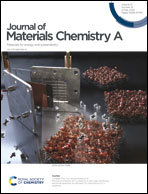Reprogramming the redox states of nickel via interface engineering and heteroatom doping to boost overall water splitting†
Abstract
The electrolysis of water using solar-generated electricity is an effective way to produce hydrogen energy. However, efficient and stable water electrolysis remains a challenge. In particular, the design of a bifunctional electrocatalyst with excellent performance and stability is the key to realizing high-efficiency water splitting. Here, through a simple two-step electrochemical method, we have combined doping and heterostructure construction to synthesize a Cu- and Fe-co-doped Ni/Ni(OH)2 heterostructured electrocatalyst (EO-Cu3-Fe2-Ni50/NF) with excellent hydrogen evolution reaction (HER) and oxygen evolution reaction (OER) dual catalytic functions. XPS and in situ Raman spectroscopy show that the Cu and Fe co-doping optimizes the electronic structure of the catalyst by decreasing the oxidation state of Ni in the catalytic process, which thereby reduces the energy barrier of electron transfer and improves the oxygen production efficiency. In addition, the Ni/Ni(OH)2 heterostructure provides plentiful HER-active Ni–Ni(OH)2 interfaces, and these interfaces are further stabilized by Fe doping, thereby enhancing the HER performance. With the dual strategy, the HER and OER catalytic activities of EO-Cu3-Fe2-Ni50/NF are greatly optimized so that at a current density of 10 and 100 mA cm−2, ultra-low overpotentials of 25 and 88 mV, and 202 and 240 mV can be achieved, respectively. EO-Cu3-Fe2-Ni50/NF also exhibits excellent stability for the OER such that a current density of 100 mA cm−2 can be maintained for at least 100 hours without obvious attenuation. And when the catalyst is used for both the anode and cathode for alkaline water electrolysis, a remarkable low cell voltage of 1.439 V is required to deliver a current density of 10 mA cm−2, and it could last for at least 36 hours. The efficient and stable water electrolysis of EO-Cu3-Fe2-Ni50/NF surpasses that of most non-noble metal-based electrocatalysts.



 Please wait while we load your content...
Please wait while we load your content...